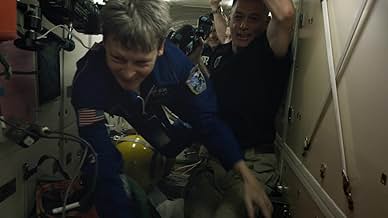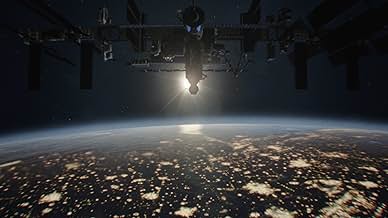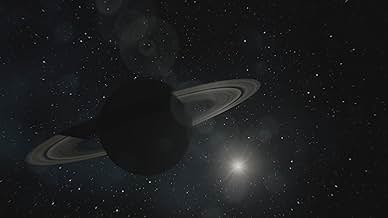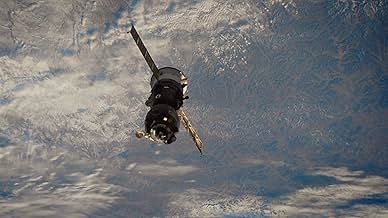AVALIAÇÃO DA IMDb
8,7/10
8,5 mil
SUA AVALIAÇÃO
A extraordinária história da Terra contada por astronautas através de uma perspectiva única.A extraordinária história da Terra contada por astronautas através de uma perspectiva única.A extraordinária história da Terra contada por astronautas através de uma perspectiva única.
- Prêmios
- 1 vitória e 3 indicações no total
Explorar episódios
Avaliações em destaque
Oh if only more TV was this quality! Well shot, well produced, execellent narrative, meaningful. Every bit as good as Blue Planet. For every age 3-103. Thank you to all who labored to bring us this incredible program. I hope it is long lived.
10jbdecker
Vivid and thought provoking. Photography and visuals are stunning. Fascinating perspectives from astronauts. Planet Earth on steroids!
Gives you a deep appreciation for earth and all of its complexities. Videography is simply stunning. An absolute MUST watch!
Some of the negative reviews here do tell a certain truth, One Strange Rock does not necessarily break all.sorts of new ground with a sorts of new information. It does deliver though, it's a beautiful show and the information is delivered in new and stunnunstu beautiful ways. To not watch this show because you think you've heard it all before would be a practice in absolute arrogance and unfortunate ignorance. The last thing any of us need to do is fool ourselves in to thinking we have learned enough. We owe it to all of these people to educate ourselves with the information they gave their lives bringing to all humanity:
Mission: Apollo 1 Date: Jan. 27, 1967 Fatalities: Gus Grissom, Edward White II, Roger Chaffee What happened: During a launch-sequence rehearsal for NASA's AS-204 Apollo mission, the cabin was filled with pure oxygen as part of its environmental control system. An electrical fault sparked a flash fire in the cabin. The fire spread quickly in the pure oxygen atmosphere, suffocating all three Apollo 1 crew members through smoke inhalation. The launch pad test site was renamed Apollo 1 in honor of the crew, and the accident led to major design and engineering modifications as well as revisions to test planning operations and manufacturing procedures.
Mission: Soyuz 1 Date: April 24, 1967 Fatalities: Vladimir Komarov What happened: Soyuz 1, the Soviet space program's one-day mission, launched on April 23, 1967, but soon began experiencing various mechanical issues the solar panels did not unfold, and the vessel experienced stability problems. After the Soyuz module re-entered the atmosphere April 24, its parachute did not open properly, causing it to crash to Earth at almost full speed. Cosmonaut Vladimir Komarov died on impact.
Advertisement
Mission: Soyuz 11 Date: June 30, 1971 Fatalities: Georgi Dobrovolski, Viktor Patsayev, Vladislav Volkov What happened: Soyuz 11 launched on June 6, 1971, and docked with the space station Salyut 1 for a three-week stay. When the vehicle undocked, a valve on the Soyuz 11 accidentally opened, causing a pressure leak in the cabin. The three cosmonauts were killed as the capsule depressurized during preparations for atmospheric re-entry on June 30. The malfunctioning valve was discovered only when the module was opened by a recovery team.
Mission: STS-51-L Date: Jan. 28, 1986 Fatalities: Greg Jarvis, Christa McAuliffe, Ronald McNair, Ellison Onizuka, Judith Resnik, Michael J. Smith, Dick Scobee What happened: During the Space Shuttle Challenger's 10th mission, STS-51-L, the rockets propelling the vessel exploded 73 seconds after launching from the Kennedy Space Center in Florida. All seven crew members were killed. President Ronald Reagan formed the Rogers Commission to investigate the accident, and its analysis concluded it had been caused by the failure of an O-ring seal on one of the solid rocket boosters. The Challenger disaster resulted in a 32-month hiatus for the shuttle program .
Mission: STS-107 Date: Feb. 1, 2003 Fatalities: Rick D. Husband, William McCool, Michael P. Anderson, David M. Brown, Kalpana Chawla, Laurel B. Clark, Ilan Ramon What happened: At the end of its two-week mission, the Space Shuttle Columbia disintegrated as it re-entered the Earth's atmosphere. The accident was determined to have been caused by damage that had occurred during liftoff, when a chunk of insulating foam broke off from the external tank and hit the orbiter's left wing. The structural failure of the shuttle's leading wing ultimately resulted in the spacecraft breaking apart, killing the seven-person crew. All of the NASA space shuttle program's flight operations were delayed for 29 months following the disaster.
Mission: Apollo 1 Date: Jan. 27, 1967 Fatalities: Gus Grissom, Edward White II, Roger Chaffee What happened: During a launch-sequence rehearsal for NASA's AS-204 Apollo mission, the cabin was filled with pure oxygen as part of its environmental control system. An electrical fault sparked a flash fire in the cabin. The fire spread quickly in the pure oxygen atmosphere, suffocating all three Apollo 1 crew members through smoke inhalation. The launch pad test site was renamed Apollo 1 in honor of the crew, and the accident led to major design and engineering modifications as well as revisions to test planning operations and manufacturing procedures.
Mission: Soyuz 1 Date: April 24, 1967 Fatalities: Vladimir Komarov What happened: Soyuz 1, the Soviet space program's one-day mission, launched on April 23, 1967, but soon began experiencing various mechanical issues the solar panels did not unfold, and the vessel experienced stability problems. After the Soyuz module re-entered the atmosphere April 24, its parachute did not open properly, causing it to crash to Earth at almost full speed. Cosmonaut Vladimir Komarov died on impact.
Advertisement
Mission: Soyuz 11 Date: June 30, 1971 Fatalities: Georgi Dobrovolski, Viktor Patsayev, Vladislav Volkov What happened: Soyuz 11 launched on June 6, 1971, and docked with the space station Salyut 1 for a three-week stay. When the vehicle undocked, a valve on the Soyuz 11 accidentally opened, causing a pressure leak in the cabin. The three cosmonauts were killed as the capsule depressurized during preparations for atmospheric re-entry on June 30. The malfunctioning valve was discovered only when the module was opened by a recovery team.
Mission: STS-51-L Date: Jan. 28, 1986 Fatalities: Greg Jarvis, Christa McAuliffe, Ronald McNair, Ellison Onizuka, Judith Resnik, Michael J. Smith, Dick Scobee What happened: During the Space Shuttle Challenger's 10th mission, STS-51-L, the rockets propelling the vessel exploded 73 seconds after launching from the Kennedy Space Center in Florida. All seven crew members were killed. President Ronald Reagan formed the Rogers Commission to investigate the accident, and its analysis concluded it had been caused by the failure of an O-ring seal on one of the solid rocket boosters. The Challenger disaster resulted in a 32-month hiatus for the shuttle program .
Mission: STS-107 Date: Feb. 1, 2003 Fatalities: Rick D. Husband, William McCool, Michael P. Anderson, David M. Brown, Kalpana Chawla, Laurel B. Clark, Ilan Ramon What happened: At the end of its two-week mission, the Space Shuttle Columbia disintegrated as it re-entered the Earth's atmosphere. The accident was determined to have been caused by damage that had occurred during liftoff, when a chunk of insulating foam broke off from the external tank and hit the orbiter's left wing. The structural failure of the shuttle's leading wing ultimately resulted in the spacecraft breaking apart, killing the seven-person crew. All of the NASA space shuttle program's flight operations were delayed for 29 months following the disaster.
Executive produced by Darren Aronofsky, and made by Will Smith's production company (Smith is also the presenter), One Strange Rock is essentially about the experiences of eight astronauts, and how their time in space led them to see Earth with new eyes. That, in turn, is used as a jumping off point to examine several different branches of Earth Science, with each episode focusing on a specific astronaut and dealing with a specific topic; the planet's respiratory system, the Theia Impact theory, how the planet protects us from the sun, the origin of life, the Permian-Triassic Extinction, the possibility of colonising another planet, how life has both transformed the Earth and been transformed by it, the evolution from single celled microbes to complex organisms, the development of the human brain, and the concept of Earth as home.
Along the way, the show throws up a litany of hard to believe facts. To give just a sampling; the Amazon produces twenty times more oxygen than all of humanity could use, but none of it leaves the Amazon Basin, as it is used by the animals living there; the magnetic field generated by the planet's core stretches for 400,000 miles into space in every direction; every strand of DNA in the world contains billions of carbon atoms to bind it together; the human body has 37 trillion cells (more than the stars in the galaxy); tropical islands are composed of up to 70% parrot fish excrement; photosynthesis generates 100 terrawatts of energy per year, six times more than humanity could use; the human brain is the most complex object in the known universe; 95% of all animals that have ever existed are extinct. Easily my favourite take from the show, however, is that it's 250,000 miles to the moon, 700 million miles to Saturn, 9 trillion miles to the edge of the solar system, 24 trillion miles to the nearest star (with our current technology, it would take 17,000 years to get there), and 25,000 light years (150,000 trillion miles) to the edge of the galaxy. That's a whole lotta miles!
Very enjoyable stuff. My one complaint would be that most of the episodes feel a little padded, with each one containing two or three diversionary stories only tangentially related to the core theme. But it's still well worth watching; terrific visuals, great sound, experts who know what they're talking about, and mind blowing information, if the goal was to make the viewer look at Earth in a new manner, they certainly succeeded with me.
Along the way, the show throws up a litany of hard to believe facts. To give just a sampling; the Amazon produces twenty times more oxygen than all of humanity could use, but none of it leaves the Amazon Basin, as it is used by the animals living there; the magnetic field generated by the planet's core stretches for 400,000 miles into space in every direction; every strand of DNA in the world contains billions of carbon atoms to bind it together; the human body has 37 trillion cells (more than the stars in the galaxy); tropical islands are composed of up to 70% parrot fish excrement; photosynthesis generates 100 terrawatts of energy per year, six times more than humanity could use; the human brain is the most complex object in the known universe; 95% of all animals that have ever existed are extinct. Easily my favourite take from the show, however, is that it's 250,000 miles to the moon, 700 million miles to Saturn, 9 trillion miles to the edge of the solar system, 24 trillion miles to the nearest star (with our current technology, it would take 17,000 years to get there), and 25,000 light years (150,000 trillion miles) to the edge of the galaxy. That's a whole lotta miles!
Very enjoyable stuff. My one complaint would be that most of the episodes feel a little padded, with each one containing two or three diversionary stories only tangentially related to the core theme. But it's still well worth watching; terrific visuals, great sound, experts who know what they're talking about, and mind blowing information, if the goal was to make the viewer look at Earth in a new manner, they certainly succeeded with me.
Você sabia?
- CuriosidadesThe documentary was released on Netflix.
Principais escolhas
Faça login para avaliar e ver a lista de recomendações personalizadas
- How many seasons does One Strange Rock have?Fornecido pela Alexa
Detalhes
- Data de lançamento
- País de origem
- Centrais de atendimento oficiais
- Idioma
- Também conhecido como
- Невідома планета Земля
- Empresas de produção
- Consulte mais créditos da empresa na IMDbPro
- Tempo de duração47 minutos
- Cor
Contribua para esta página
Sugerir uma alteração ou adicionar conteúdo ausente




































